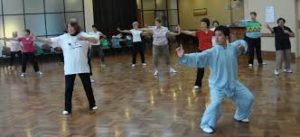Improve Type 2 Diabetes with Qigong Practice
By John M. de Castro, Ph.D.
“In addition to the importance of moderate physical activity, the relaxation element of Tai Chi may help to reduce stress levels, preventing the release of adrenalin which can lead to insulin resistance and high blood glucose levels.” – Cathy Moulton
Diabetes is a major health issue. It is estimated that 30 million people in the United States have diabetes and the numbers are growing. Type 2 Diabetes results from a resistance of tissues, especially fat tissues, to the ability of insulin to promote the uptake of glucose from the blood. As a result, blood sugar levels rise producing hyperglycemia. Diabetes is the 7th leading cause of death in the United States. In addition, diabetes is heavily associated with other diseases such as cardiovascular disease, heart attacks, stroke, blindness, kidney disease, and circulatory problems leading to amputations. As a result, diabetes doubles the risk of death of any cause compared to individuals of the same age without diabetes.
Type 2 diabetes is a common and increasingly prevalent illness that is largely preventable. One of the reasons for the increasing incidence of Type 2 Diabetes is its association with overweight and obesity which is becoming epidemic in the industrialized world. Qigong and Tai Chi have been practiced for thousands of years with benefits for health and longevity. Qigong and Tai Chi trainings are designed to enhance function and regulate the activities of the body through controlled breathing, mindful concentration, and gentle movements. Only recently though have the effects of these practices been scrutinized with empirical research. This research has found that they are effective for an array of physical and psychological issues.
Diet and exercise are prescribed to treat Type 2 Diabetes. Qigong and Tai Chi are gentle exercises that may be acceptable to the generally exercise averse obese. So, they may be useful in treating Type 2 Diabetes. In today’s Research News article “Qigong Exercises for the Management of Type 2 Diabetes Mellitus.” (See summary below or view the full text of the study at: https://www.ncbi.nlm.nih.gov/pmc/articles/PMC5622394/), Putiri and colleagues review and summarize the published research literature on the application of Qigong practice for the treatment of Type 2 Diabetes.
They report that the published research literature finds that Qigong practice produces significant improvements in blood glucose, triglycerides, total cholesterol, weight, BMI and insulin resistance in patients with Type 2 Diabetes. It is known that exercise and weight reduction improves Type 2 Diabetes. In addition, stress tends to exacerbate the disorder. So, Putiri and colleagues speculate that the benefits of Qigong for Type 2 Diabetes are due to the aerobic exercise, weight loss, and stress reduction provided by the practice.
These are exciting findings. Qigong is a gentle practice, completely safe, can be used by anyone, including the elderly and sickly, is inexpensive to administer, is convenient as it can be performed in groups or alone, at home or in a facility or even public park, and can be quickly learned. In addition, it can also be practiced in social groups without professional supervision. This can make it fun, improving the likelihood of long-term engagement in the practice. This suggests that Qigong practice may be an ideal alternative treatment for Type 2 Diabetes.
So, improve Type 2 Diabetes with qigong practice.
“Qigong is brilliant but it is not a miracle worker. It is merely a tool to maintaining good health and to prevent and improve your health; HOWEVER you may need to improve other aspects of your life such as increasing exercise (where Qigong can help) and changing the diet (removing toxic additives and sugar / processed products).” – Udemy
CMCS – Center for Mindfulness and Contemplative Studies
This and other Contemplative Studies posts also available on Google+ https://plus.google.com/106784388191201299496/posts and on Twitter @MindfulResearch
Study Summary
Putiri, A. L., Close, J. R., Lilly, H. R., Guillaume, N., & Sun, G.-C. (2017). Qigong Exercises for the Management of Type 2 Diabetes Mellitus. Medicines, 4(3), 59. http://doi.org/10.3390/medicines4030059
Abstract
Background: The purpose of this article is to clarify and define medical qigong and to identify an appropriate study design and methodology for a large-scale study looking at the effects of qigong in patients with type 2 diabetes mellitus (T2DM), specifically subject enrollment criteria, selection of the control group and study duration. Methods: A comprehensive literature review of English databases was used to locate articles from 1980–May 2017 involving qigong and T2DM. Control groups, subject criteria and the results of major diabetic markers were reviewed and compared within each study. Definitions of qigong and its differentiation from physical exercise were also considered. Results: After a thorough review, it was found that qigong shows positive effects on T2DM; however, there were inconsistencies in control groups, research subjects and diabetic markers analyzed. It was also discovered that there is a large variation in styles and definitions of qigong. Conclusions: Qigong exercise has shown promising results in clinical experience and in randomized, controlled pilot studies for affecting aspects of T2DM including blood glucose, triglycerides, total cholesterol, weight, BMI and insulin resistance. Due to the inconsistencies in study design and methods and the lack of large-scale studies, further well-designed randomized control trials (RCT) are needed to evaluate the ‘vital energy’ or qi aspect of internal medical qigong in people who have been diagnosed with T2DM.
